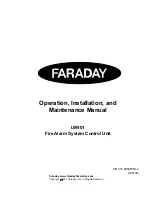
12
Operation, Installation, and Maintenance Manual
LW-401
Figure 7
Line Graph of Alarm Verification
Alarm Verification in the LW-401 is applied
globally to all selected zones. Therefore,
when a detector reaches its alarm threshold
and begins the Alarm Verification Time cycle,
any detector on any alarm verified zone will
react to smoke conditions as if its own Alarm
Verification Cycle had begun with the first
detector.
Generic Zone
The generic zone is activated (or alarmed)
by the output from another control panel.
This output should be made with a contact
device connected across the Generic zone.
When activated, it causes the notification
appliance circuits to sound and the appropri-
ate initiating Zone LED to light. When the
input is deactivated, the NACs will silence.
The System alarm contacts do not change
state.
Notification Appliance Circuit (NAC or
Bell Circuit) Type (Program Level 4)
The LW-401 has two Notification Appliance
Circuits, each circuit is rated at 1.5 amps.
The Notification Appliance Circuits can each
be programmed for one of the following four
code choices:
1. Steady NAC
2. Temporal Code
3. March Time Code
4. Simple Zone Code
A steady tone is the default choice for each
circuit. A nonsilenceable NAC has a steady
tone. Temporal Code is as defined by NFPA
72. (Simple Zone Code is explained below.)
Please note that while it is possible to pro-
gram the two NACs with different, non-
steady codes, it is not permitted by any
authority. Use only one nonsteady code in
your LW-401 system.
When distributing power in the system,
remember that there are 3 amps available
between the two NACs and the auxiliary
output. Do not exceed 3 amps total current
draw from the system.
Simple Zone Code
Notification Appliance Circuits programmed
for simple zone code follow a pre-pro-
grammed code pattern. Devices are turned
on and off once for Zone 1 alarms, twice for
Zone 2 alarms, three times for Zone 3 alarms,
etc. The first alarm’s code is repeated for the
number of rounds programmed in the sys-
tem, then the next alarm is reported. The
minimum allowable number of rounds is
three.
When all zones in alarm complete their
specified number of rounds in turn, the entire
sequence begins again with the first zone in
alarm. This sequence is repeated until the
system is silenced or reset.
The system operator cannot silence the
appliances, or reset the system, until the
programmed number of rounds of code have
been completed for each alarm. After silenc-
ing the appliances, the system reports a new
alarm via its particular code, followed by a
resound of all previously silenced alarms.





































